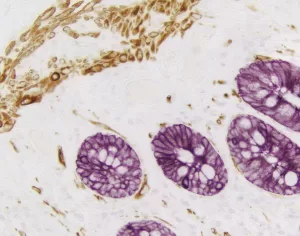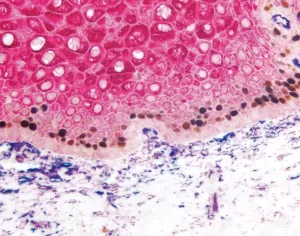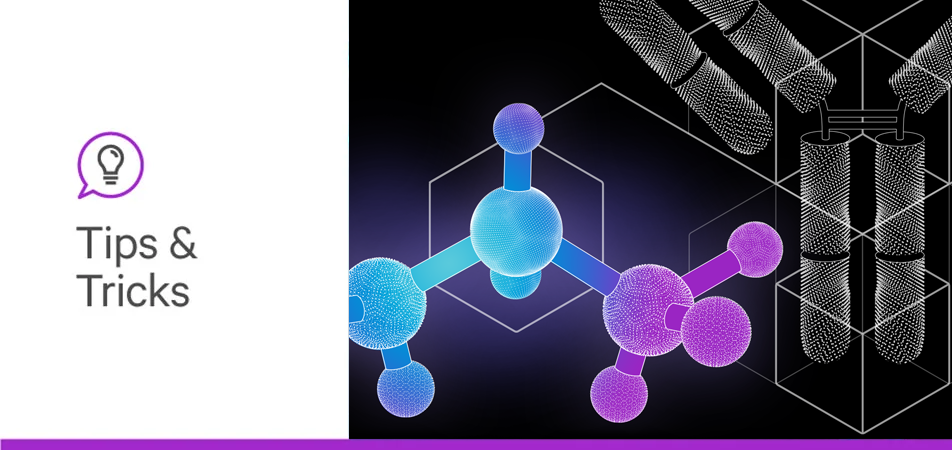

Avidin-Biotin Complex, or ABC-based detection, is one of the most widely used methods for staining. This method exploits the high affinity exhibited between the protein avidin and the vitamin biotin forming large macromolecular complexes containing multiple enzyme molecules—either horse radish peroxidase (HRP) or alkaline phosphatase (AP).
These added complexes bind to any biotinylated target, such as primary or secondary antibodies, nucleic acids, lectins, and macromolecules. When the chromogenic enzyme substrate is applied, it yields a colored precipitate at the reaction site.
VECTASTAIN® ABC detection systems are uniquely formulated with our Avidin DH and biotinylated enzyme conjugates to deliver enhanced signal sensitivity with low background. These reliable and economical VECTASTAIN ABC Systems have come to be a mainstay product in immunohistochemistry (IHC) laboratories.
The original VECTASTAIN ABC kits are offered in both AP and HRP detection systems. They include a biotinylated antibody, the ABC complex, and normal serum from the host species of the secondary antibody for blocking. These are our most economical options.
The VECTASTAIN Elite ABC kits are specifically made with the HRP detection system. They are our most sensitive kits offering a smaller and more uniform avidin-biotin complex with 5 times the sensitivity compared to the original HRP kits. These kits also include a biotinylated secondary antibody and normal serum along with the ABC reagent.
Both the VECTASTAIN Elite HRP kits and the Original HRP and AP kits have 2 additional offerings. The first is a Universal version. In this kit, the secondary antibody is not specific to a certain species, but rather has broad detection for more than 1 species.
The second format offered is the Standard version of the kit which does not include the biotinylated antibody or the normal serum, just the ABC complex. This format is beneficial for researchers who have their own biotinylated reagent.

When determining which VECTASTAIN ABC Kit is ideal for an application, there are a few considerations to make. The first is choosing the detection enzyme—HRP or AP. Typically, the deciding factor between these 2 enzymes is the preferred substrate to be used for color production.
Next, it is important to decide if a biotinylated secondary antibody is necessary. A protocol with a biotinylated reagent sourced elsewhere would need a VECTASTAIN ABC Standard kit which does not include a biotinylated antibody. Alternatively, if a biotinylated antibody is needed, the species needs to be decided.
VECTASTAIN ABC kits are offered with a wide range of species options. Common species are mouse, rat, and rabbit, but we also carry versions of goat, sheep, human, and guinea pig. For example, to detect a primary antibody made in rabbit, the appropriate choice is a VECTASTAIN ABC Kit designated Rabbit IgG.
Within the peroxidase VECTASTAIN Kits, there is a choice of sensitivity. For lower expressing or hard to detect antigens, the VECTASTAIN Elite ABC HRP kits offer greater sensitivity and would be preferrable.
Finally, the VECTASTAIN ABC Kits are available in economical concentrated formats. Alternatively, for additional convenience and ease of use, some peroxidase-based kits are offered in ready-to-use, prediluted stabilized formats.
The VECTASTAIN ABC Kits cover 1 or multiple steps in a standard immunostaining assay. Regardless of the kit used, there will also be some required ancillary products in the workflow.
In general, the first step of a workflow involves blocking. Unwanted signals are blocked to prevent background staining and false positives. The type of blocking reagent used depends on what is causing the unwanted signal. For example, the VECTASTAIN ABC Kits utilize the strong avidin-biotin affinity. This means endogenous biotin in a sample can be detected by the ABC complex.
To avoid this, biotin blocking can be performed with a product such as our Avidin/Biotin Blocking Kit (SP-2001). Other forms of blocking include blocking endogenous HRP or AP and general protein blocks with normal serum, for example, the normal serum provided in some VECTASTAIN ABC Kits.
The next reagent necessary for a protocol is a primary antibody to detect the target antigen. It is important that the primary antibody host species matches the target species of the secondary antibody.
After the primary antibody, the biotinylated secondary antibody is used. This reagent is found in most VECTASTAIN ABC Kits and if not, can be sourced separately. Next, the ABC Reagent is used after the biotinylated reagent incubation.

Finally, an assay involving the VECTASTAIN ABC Kit needs an enzyme substrate. Vector Laboratories offers a wide range of both HRP and AP substrates. These substrates react with the detection enzyme to deposit a colored chromogen at the site of the target antigen for visualization. To learn more about selecting an enzyme substrate for IHC, check out our blog post, A Simple Guide to Immunohistochemistry Enzyme Substrate Selection.
Some applications may not be compatible with a biotin-based detection system. For example, tissue samples expressing endogenous biotin can lead to non-specific signal because the VECTASTAIN ABC reagent will detect this endogenous biotin. In this case, there are a few options. The first would be to add a biotin blocking step, like mentioned above.
Another option would be to switch to an enzyme polymer detection system like our ImmPRESS® Kits. These kits integrate secondary antibodies with a high-density micropolymer array of reporter enzyme without using the avidin-biotin interaction. This technique introduces more enzymes at the site of primary antibody localization, yields a stronger signal with lower background, and simplifies detection into a single incubation step.
A unique species of primary antibody may be necessary for which there is not a VECTASTAIN Kit option. In this case, a researcher can acquire a separate biotinylated antibody directed against their desired species. The researcher can then use the VECTASTAIN ABC Standard Kit or the VECTASTAIN Elite ABC Standard Kit for the detection of that biotinylated antibody.
With more than 60,000 citations to its credit, Vector Laboratories’ VECTASTAIN ABC systems are widely popular and are a staple product for immunodetection. To learn more about the use of VECTASTAIN products and similar applications, get a free copy of our Immunohistochemistry Resource Guide and be sure to stay tuned to the SpeakEasy Science Blog.





Stay in the Loop. Join Our Online Community
Products
Ordering
About Us
Application
Resources

©Vector Laboratories, Inc. 2025 All Rights Reserved.
To provide the best experiences, we use technologies like cookies to store and/or access device information. Consenting to these technologies will allow us to process data such as browsing behavior or unique IDs on this site. Not consenting or withdrawing consent, may adversely affect certain features and functions. Privacy Statement